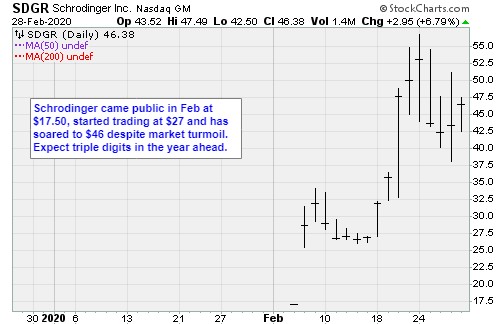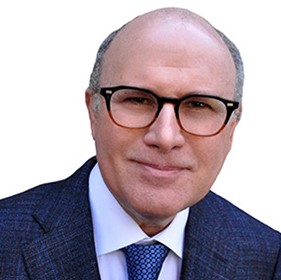Gates-backed IPO Could Revolutionize Drug Development
A software company backed by Bill Gates and hedge fund legend David Shaw is about to disrupt the pharmaceutical industry.
Schrodinger (SDGR) uses breakthrough artificial intelligence to help companies discover new drugs faster and cheaper. Shares debuted Feb. 5 and promptly soared. Then the coronavirus hit.
COVID-19 may have stolen the spotlight for now. But that won’t be the case for long. Schrodinger is unique, and not just because of the interest from Gates and Shaw — who combined control 50% of the business.
No, what’s unique is what they saw. That is the real story.
The New York software business is tackling the most difficult and costly part of drug discovery with AI, machine learning and physics-based predictive analytics. The platform has become the industry standard for molecular simulation.
The company takes its name from Erwin Schrodinger, a Nobel Prize-winning physicist born in 1887. The Austrian is best known for his Schrodinger’s Cat thought experiment based on quantum psychics and superposition.
It argues that a cat placed in a closed box with radioactive material could be both alive and dead simultaneously. It’s only the act of opening the box determines the state. Talk about curiosity killing the cat.
Schrodinger, the software business, is about not killing the cat. Its platform uses emergent technologies to predict status.
To do this, the company has assembled 150 PhD scientists. They have published over 400 peer-reviewed white papers on physics-based approaches and computer modelling.
And although the field for computational biology is competitive, in its prospectus filed with the Securities and Exchange Commission in January, Schrodinger managers took the unusual step of claiming it is now far ahead of the nearest competitors.
It’s a bold claim, but it’s backed up facts.
The software is in use at 1,250 academic institutions worldwide. The platform also claims patronage of the top 20 pharmaceutical companies, as measured by sales. The customer retention rate for all its 1,150 customers, according to the prospectus, is 96%.
The pharmaceutical industry spent $179 billion on research and development during 2018, according to Statista. The market is expected to swell to $202 billion by 2022.
So far, Schrodinger has a tiny sliver of that business. The company generated $66 million in sales in 2018, a 20% increase year-over-year. Due to extensive spending in R&D and new hiring, the company had losses of $18.5 million during that time frame. Despite this, the future is bright.
The company is at the epicenter of a larger digital transformation. Managers say the company’s software tools are currently being used to develop only one to two new discovery projects at each of its leading customers. This is likely to change.
Boston Consulting Group notes that biotech and pharma must embrace digital transformation now to remain competitive. Future sector winners will be those businesses that digitize the core of the enterprise. If they can’t reduce discovery costs while expediting development, they are going to be disrupted.
Schrodinger raised $232 million in its February IPO, issuing 13.7 million shares at $17 apiece. The stock immediately zoomed to $27.22 on the opening day. Since that time the stock has added another $19.16, reaching $46.33 for a market capitalization of $2.2 billion.
While that is impressive, the rise was probably stunted by the market weakness during February.
The company is being favorably compared to Tesla (TSLA), another disruptive software business that was largely misunderstood in its early stages.
Citron Research, an investment firm famous for its bearish notes, told clients in February that a Schrodinger investment might be like Tesla in the early stages, only better.
The company has more proprietary technology, and unlike early Teslas, the science project portion of the business is already proven.
The prospects for Schrodinger are as good as any new business in recent memory. The operation was funded by visionary investors. Big pharma has deep pockets and it is in the midst of a digital transformation. Schrodinger is the market leader with a tiny share.
Erwin Schrodinger spent the second half of his career doing biology research. He rejected the theory he created because the idea of something being in two disparate states at the same time seemed absurd. However, superposition proved very real.
Growth-oriented investors should consider using any weakness to buy Schrodinger shares. It’s both small and the next big thing, simultaneously.
Best wishes,
Jon D. Markman




